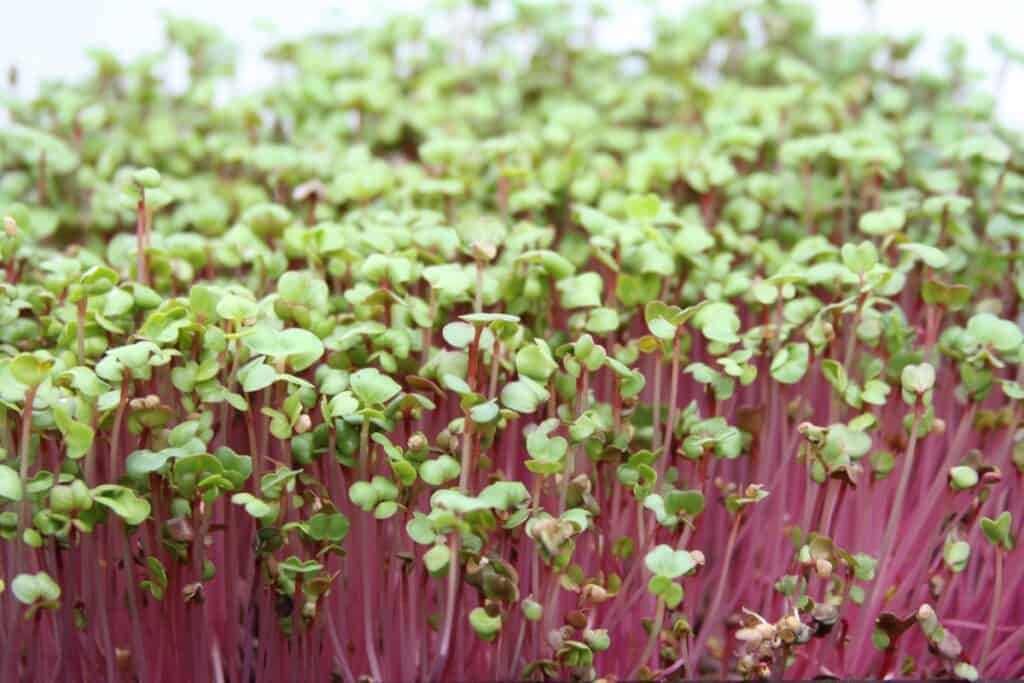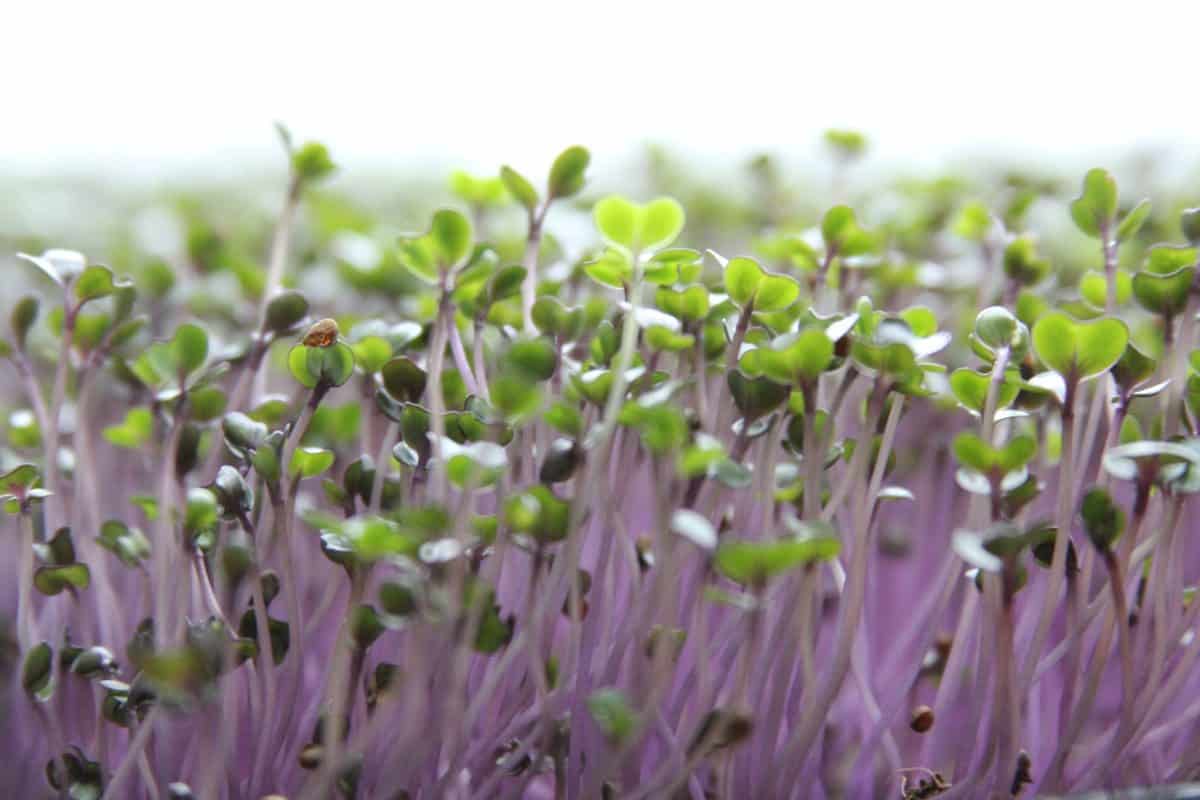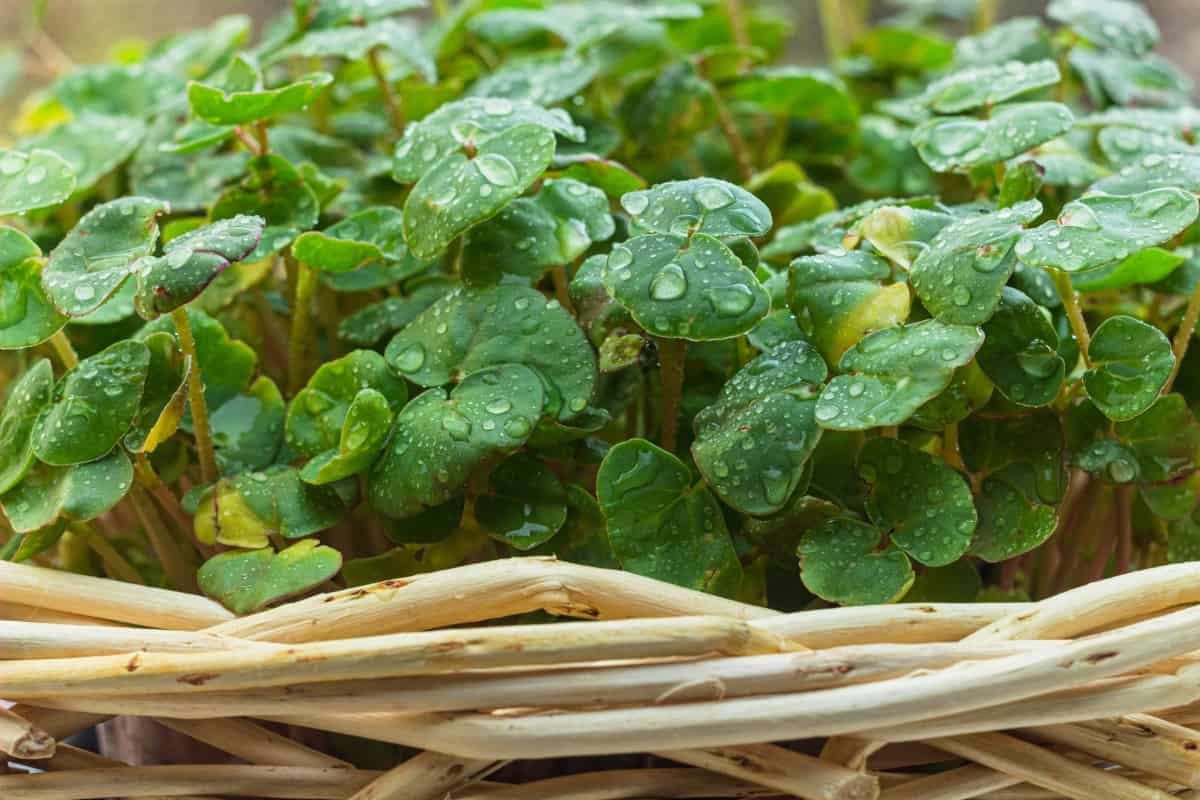When you look up the list of edible microgreens, the catalog includes over one hundred varieties. But what determines whether a plant can be eaten as a microgreen or not? That’s what I decided to investigate.
Many plants can be grown and eaten as microgreens. The safest choices for microgreens are leafy green vegetables and herbs. Fruiting vegetables, on the other hand, are not suitable for growing microgreens, such as tomatoes, squash, and peppers. For other species of vegetables, grains, and legumes, you need to buy seeds that are specifically labeled as microgreen seeds.
Even though most microgreens are safe, some seeds sold for microgreen growing are either not tasty, too difficult to grow, and some are even toxic. Since the main benefits or microgreens include their exceptional flavor and high nutrient content, avoid those that do not provide either.
Which Microgreens are Edible?
Over a hundred crops have been grown as microgreens and people are still experimenting with more. Some are naturally safer and tastier. Plants that are grown for their leaves are the top choice, since their leaves are already eaten in larger forms. These include cabbage, kale, arugula, lettuce, broccoli, mustard greens, chard, beet, endive, sorrel, watercress, and Asian greens. These microgreens are generally easy to grow.
Leaves of certain root and bulb vegetables are also commonly grown and safe to eat, including radish, kohlrabi, turnip, fennel, carrot, and celery.
Most herbs will also work well as microgreens, for the same reason as leafy green vegetables: their edible parts are their leaves. Examples include basil, cilantro, marjoram, dill, and parsley. Herbs are usually more difficult to grow, and they take longer.
Certain grains have also been grown as microgreens. You are probably familiar with wheatgrass, which is usually consumed as juice. Other grains that are safe to eat include amaranth and yellow popcorn.
Certain legumes and other seeds are also popular and edible, such as peas and sunflower seeds. Some less common microgreens include clover, flax, onions, garlic, mung bean, and sesame seeds.
10 Common Microgreens
If you are not sure about the safety or flavor of microgreens, it’s best to start with old-time favorites that haven been grown extensively. These are the greens that you will find in health food stores, and these are the most commonly sold seeds for growing. Some microgreens have been used by chefs for decades, so it’s safe to follow their choices in what’s definitely edible and tasty.
The most commonly grown and sold microgreens are:
Radish
Broccoli
Pea
Sunflower
Arugula
Kale
Basil
Amaranth
Kale
Chive
10 Easy-To-Grow Microgreens
If you are a beginner looking to grow your own microgreens, there are some microgreens that grow easily and quickly and are suitable for novices.

Radish: There are many varieties of radishes. Red and daikon are the most common. Daikon tastes a bit milder than the red ones. Radish is the quickest and easiest of all seeds to germinate and grow. It can be harvested within 5-7 days.
Peas: Peas are also easy to grow, especially if you soak the seeds for 12-24 hours. Peas take a few days to germinate but then they grow relatively fast, so you can harvest them within a week. They taste just like fresh peas.

Red cabbage: Red cabbage is relatively easy to grow. The seeds take 2 to 4 days to germinate and another 5 to 7 to harvest. They have a sweet cabbage flavor.
Red Russian Kale: Another very easy to grow and quick microgreen. It germinates in 2 to 3 days and can be harvested in 8 to 12 days. The microgreens taste like kale with a beautiful pinkish red stem and dark green leaves. I have found this variety of kale to be the most reliable, although other kale varieties will also perform well as microgreens.
Mustard: These spicy microgreens germinate in 2 to 3 days and can be harvested within 6 to 10 days after germination. Mustard can tolerate cold weather easily. There are many varieties of mustard, and their flavor ranges from mildly to very spicy.
Asian greens, especially komatsuna: These greens also germinate quickly, in about 2 days. Some have mild mustard-like taste, others taste neutral. Some other varieties in this category include altor, green or purple mizuna, hon tsai tai and yukina savoy.
Arugula: This tangy salad green also works well as a microgreen. It germinates in 1 to 2 days and can be harvested in 7 days after germination, so it’s fairly quick to grow. Arugula likes cool temperatures.
Bok Choi: (AKA Pac Choi) Another Asian green that’s easy to grow and quick. It germinates in 2 days and can be harvested within 8 to 12 days. It has a unique flavor that goes well in salads.
Napa Cabbage: (AKA Chinese Cabbage) Depending on the variety, they germinate in 2 to 5 days and can be harvested in 8 days. They germinate very easily even in lower temperatures. Their flavor resembles lettuce more than cabbage. They have a unique yellow-green color.
Which Microgreens Not to Eat?
Microgreens that may be unhealthy or toxic.

Buckwheat microgreens have the potential to be harmful if eaten in larger quantities. Buckwheat grains contain a toxin called fagopyrin, which can increase the skin’s photosensitivity, resulting in redness and burning. Some people also experience numbing, tickling and itching sensations of the skin. Read more about this here.
Some other microgreens, including alfalfa and quinoa, contain various anti-nutrients, which if consumed in large amounts can cause indigestion and inflammation.
Other grains, such as millet, are also grown as microgreens but not for human consumption. They are for pet birds and hamsters.
Some people are also concerned about microgreens of larger beans such as fava beans. Some people are also allergic to them. There hasn’t been much research done on the safety of microgreens. Raw beans contain anti-nutrients, which can cause serious digestive discomfort. Cooking reduces the amount of these anti-nutrients to a safe amount. Whether we need to worry about these anti-nutrients in microgreens from large beans is not clear yet.
Microgreens that are difficult to grow.
Some growers stay away from certain plants because they are difficult to germinate, grow slowly, and offer small yields. These include celery, corn, and mint.
Microgreens that are not tasty.
Some microgreens are sold as seeds, but they are not very tasty such as canola, chia, and collard.
Spinach, although a healthy leafy green, is usually not grown as a microgreen. The reason is that the seed’s hulls cling to the leaves and are very difficult to remove. The seed hulls are not edible, so they make the microgreens also inedible. But if you want to try to grow these and remove the hulls, the leaves are tasty and healthy.
Plants that produce fruit
There are many plants grown for the fruits they produce, such as cucumber and all types of winter and summer squashes, and these are usually not eaten for their greens. Those in the nightshade family: tomatoes, peppers, eggplant, and potatoes can even be harmful as their leaves and stems are poisonous.
It seems that the safest and easiest-to-grow microgreens are leafy greens and cruciferous vegetables. People have been eating these greens for a long time, and their health benefits have been well researched. The second-best choice are herbs along with sunflower greens and pea shoots. There are dozens of safe options among these plants for you to experiment with.
Related questions
What seeds are good for microgreens?
Microgreen seeds should be untreated and preferably organic. Some seeds are treated with fungicide, which could contaminate the harvestable portion of the seedling. Peas often have fungicide-treated seeds. It’s best to use seeds from a reputable source that have been produced specifically for microgreen growing.
Which microgreens are the cheapest to grow?
This is a difficult question because of the variables of seed price, germination rate, seed density, and yield. But I would say that if you are a beginner, the microgreens that are the easiest to grow will also be the cheapest because you will more likely succeed with them.
Which ones are the tastiest microgreens?
This is a rather subjective question, but pea shoots and sunflower greens are on the top of the list due to their sweet, delicate flavor. If you like spicy greens, go with radish or arugula microgreens.


Leave a Reply